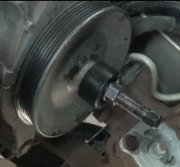OH! THAT makes more sense. You're going to need an air impact wrench to loosen the nut on the pitman arm, then you need a special jaw-type puller to pull it off the pitman shaft. A standard jaw puller is not nearly strong enough for this. Check at some local auto parts stores and find one that rents or borrows tools for the pitman arm puller.
When you try to turn the large nut, the steering shaft is going to turn too. Let it do that and come to a stop on its own at the end of its travel. You don't want to use the steering wheel lock for this. There's just a thin metal plate in there and it will likely get damaged from the pounding it will take.
Don't use any heat from a torch near the pitman arm because that will melt the seal and dust seal inside the steering gear housing. I like to use an air cutoff tool to cut a slot in the pitman arm right where it is pressed onto the splined shaft. You should be able to get most of the way through it, then it will suddenly crack apart from the extreme force on it. You may be able to remove it that way without the special puller.
You'll need an air hammer with a "pickle fork" attachment to get the stud out of the end of the center link. Don't get any grease on that stud or the splined shaft on the steering gearbox. That will reduce the friction fit that holds those parts together. If that stud were to come loose, both the pitman arm and the center link must be replaced. If the stud or the hole are deformed, those parts will never stay tight, and the stud could wobble and snap off.
GM has a real lot more trouble with idler arms than with pitman arms, so be sure to check that too. Those require special measurements when they're replaced to insure the center link is perfectly parallel to the ground. Failure to do that is why a lot of do-it-yourselfers end up with trucks that handle miserably. It sounds like the truck should be inspected at a tire and alignment shop so they can give you a detailed list of what is needed. S-10s and the small Blazers eat upper ball joints. It's common to have to replace them every two years.
If your truck uses torsion bar suspension, you can adjust the ride height if it's wrong. If you have coil springs, they must be replaced to correct sagged ride height. The people at the tire shops have small books that will show you where to take the measurements on your truck, and what they should be. If ride height is not at the specified height, the upper and lower control arms will go through the wrong arcs as the suspension goes up and down over bumps in the road. That will cause, among other things, very poor tire wear even when the alignment computer says everything is perfect.
The pulling to one side also tells me there is something wrong, more than just a worn ball joint, that has affected the alignment. Suspension and steering parts that are worn can separate leading to loss of control and crashes. Separated parts aren't real common on your truck, but they were VERY common on older Ford products. Once these parts are replaced, the truck will need an alignment. The mechanic is going to inspect the steering and suspension systems again, and if he is conscientious, he won't take your money or do the alignment if he finds more things wrong. He will just send you home to start all over again.
Thursday, June 18th, 2015 AT 8:31 PM


